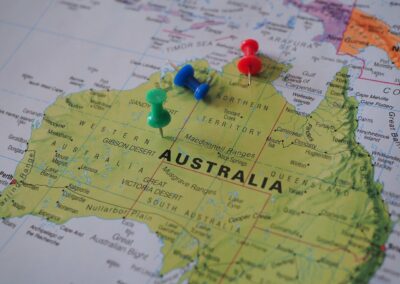Aerial mapping captures detailed images from the air to create maps of the land below. It uses drones and cameras to gather data over large areas quickly and efficiently. This method is crucial for accurate land surveys, construction planning, and environmental monitoring. Ground Control Points (GCPs) ensure the precision of these maps. In this article, we’ll explore the origins of aerial mapping, how technology has evolved, and its current applications. We’ll also look into the process itself, from early methods to the latest in drone mapping technology, and offer tips for achieving accurate results.
Historical Overview

Aerial mapping’s history is a timeline of technological advancement, from balloon photography to modern drones. Next, we’ll explore key milestones that have defined this evolution.
Early Methods of Mapping
Early mapping methods were ground-based, involving manual measurements and sketches to depict terrain. Surveyors used simple tools like compasses, chains, and theodolites to measure land and draw maps. Balloon photography, introduced in the 19th century, was the first step towards aerial mapping. It allowed for broader views, but accuracy and detail were limited. Kites and pigeons with mounted cameras offered early glimpses of mapping from the sky. These methods laid the groundwork for modern aerial mapping, providing essential lessons in perspective, scale, and the importance of accurate, detailed information for mapmaking.
The Evolution of Aerial Mapping Technology
The evolution of aerial mapping technology is filled with innovation and technological advancement. From early balloon photography, the field progressed to using airplanes and helicopters, significantly improving coverage and detail. The introduction of satellites offered even greater precision and global reach. Recently, drones have revolutionized aerial mapping, making it more accessible and cost-effective. These unmanned aerial vehicles (UAVs) carry sophisticated cameras and sensors, capturing high-resolution images. Alongside, advancements in GPS and GIS technologies have enhanced the accuracy of maps, making GCPs crucial for pinpoint precision.
How Aerial Mapping Works
Aerial mapping transforms the way we capture data from the skies above. Next, we will break down the essentials of how aerial mapping operates. We’ll cover the various systems used for mapping from the air, the sensors that gather crucial data, and the step-by-step process of collecting this information. Additionally, we’ll discuss the vital role of Ground Control Points (GCPs) in ensuring the accuracy of the final maps.
Types of Aerial Mapping Systems:
- Fixed-Wing Drones: Ideal for large, open areas due to their long flight times.
- Rotary Drones: Best for detailed, focused mapping of specific locations or smaller sites.
- Manned Aircraft: Used for extensive mapping projects that cover vast geographical areas.
- Satellites: Provide global coverage and are essential for environmental and large-scale land monitoring.
- Balloon and Kite Mapping: Low-cost options for small-scale, low-altitude mapping projects.
- Light Detection and Ranging (LiDAR) Systems: Used for creating detailed 3D models of the terrain.
- Photogrammetry: Uses overlapping photographs to create maps and 3D models of surfaces.
Sensors Used in Aerial Mapping:
- Digital Cameras: Capture high-resolution images for photogrammetry, essential for detailed map creation.
- Multispectral Sensors: Detect data across multiple wavelengths, vital for agricultural and environmental monitoring.
- Thermal Cameras: Identify heat variations, which is useful in energy audits and wildlife studies.
- LiDAR Sensors: Emit laser pulses to measure distances, which is crucial for accurate 3D terrain models.
- Radar Systems: Penetrate cloud cover and vegetation, providing data in all weather conditions.
- Hyperspectral Sensors: Capture a wide spectrum of light, offering detailed information for scientific research.
- Infrared Sensors: Useful in vegetation mapping, detecting health and biomass of plant life.
Data Collection Process
The data collection process in aerial mapping begins with careful flight planning to ensure area coverage. GCPs are then placed for map accuracy. Following this, drones capture various data types, which are processed with specialized software to create detailed maps. GCPs validate this data, leading to the production of precise final maps. This streamlined process is key to generating accurate maps for diverse industry applications.
The Role of Ground Control Points (GCPs)

GCPs are pivotal for enhancing the accuracy of aerial maps. These marked locations on the ground, identified by their precise GPS coordinates, serve as anchor points during the mapmaking process. When drones capture aerial imagery, the presence of GCPs allows for the correction and calibration of any spatial distortions, ensuring that the final map accurately represents the surveyed area. This process significantly improves both the relative and absolute accuracy of aerial maps, making GCPs indispensable in projects where precision is paramount. By integrating GCP data, mapping software can adjust and align aerial photographs with real-world coordinates, resulting in highly accurate and reliable maps.
Applications of Aerial Mapping
Aerial mapping plays a crucial role across various sectors, offering detailed insights and data from above. From shaping cities to preserving history, its applications are both diverse and impactful.
Urban Planning and Development:
In urban planning and development, aerial mapping offers a bird’s-eye view of sprawling city landscapes. This perspective helps in designing infrastructure, zoning, and land use by providing accurate, up-to-date maps. Planners use these maps to make informed decisions about where to build new developments, how to improve traffic flow, and where to allocate green spaces. It’s a tool that simplifies the planning process, ensuring cities grow in a sustainable and efficient manner.
Environmental Monitoring and Management:
Environmental monitoring and management benefit greatly from aerial mapping, tracking changes in ecosystems over time. It enables the identification of deforestation, water body changes, and habitat destruction, offering a powerful tool for conservation efforts. By analyzing aerial maps, environmentalists can spot illegal activities, monitor biodiversity, and plan restoration projects. This technology is essential for sustaining natural resources and ensuring environmental regulations are met, safeguarding our planet’s future.
Agriculture and Forestry:
Aerial mapping revolutionizes agriculture and forestry by providing detailed insights into crop health and forest management. Farmers can monitor crop growth, detect pest infestations, and optimize irrigation, leading to improved yields and resource management. In forestry, aerial maps help assess tree coverage, plan harvests, and monitor reforestation efforts. This technology enables more sustainable practices, ensuring the efficient use of land and resources in these critical sectors.
Disaster Response and Management:
Aerial mapping is indispensable in disaster response and management, offering rapid assessment of affected areas. It provides critical data for rescue operations, highlighting access routes and identifying safe zones. Emergency teams can evaluate the damage, prioritize resources, and plan effective responses with up-to-date aerial imagery. This technology speeds up recovery efforts and ensures that help reaches those in need quickly and efficiently, ultimately saving lives and reducing the impact of disasters.
Archaeology and Cultural Heritage Preservation:
Aerial mapping offers a new lens for archaeology and cultural heritage preservation, uncovering hidden relics and ancient structures. By capturing detailed images from above, researchers can identify and study archaeological sites without disturbing the ground. This method helps when mapping vast historical landscapes, conserving sites at risk, and documenting cultural treasures for future generations. It’s a non-invasive way to explore our past, ensuring that our precious heritage is preserved and understood.
Understanding the Impact of Aerial Mapping
Aerial mapping has transformed how we understand and interact with our world. From urban development to environmental conservation, agriculture, disaster management, and archaeology, its applications are vast and vital. GCPs ensure the accuracy of these aerial maps, making them indispensable tools across industries. As technology evolves, aerial mapping continues to offer unparalleled insights, driving progress and protecting both our planet and our heritage for future generations.







